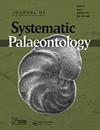主要无柄蜈蚣群的起源;白垩纪Brachylepadomorpha和Verrucomorpha的修订
IF 2.2
2区 地球科学
Q3 EVOLUTIONARY BIOLOGY
引用次数: 0
摘要
对白垩纪无柄目、短掌足目和疣足目的卷足目分类进行了修订。新分类群包括短肢动物Crithmumlepas属(模式种C. hoensis sp. nov., C. aycliffensis sp. nov.)和Calvatilepas(模式种C. recurvus sp. nov.)。建立了野野鸭科(组成属野野鸭属、野野鸭属),描述了野野鸭属;建立了一种新种barringtonensis sp. nov.。对16个群内无柄类群(Brachylepadomorpha + Verrucomorpha + Balanomorpha)的18个操作分类单元的48个性状进行枝系分析,得到了一个一致性树,该树强烈支持brachylelepadomorpha + Verrucomorpha + Balanomorpha的单系关系。建议将其组成科分别确定为茎组Verrucomorpha (Pycnolepadidae)和茎组Balanomorpha (Brachylepadidae)。Verrucomorpha和Balanomorpha的姐妹类群关系在许多分子研究中得到证实,并从壳形态数据中得到证实。Neolepadoidea被证明与verrucomorphs和balanomorphs的无根适应密切相似。关于蜈蚣进化的关键片段的化石记录被证明是显著的,令人惊讶的是,完整的。本文章由计算机程序翻译,如有差异,请以英文原文为准。
The origins of major sessile cirripede groups; a revision of Cretaceous Brachylepadomorpha and Verrucomorpha
The taxonomy of Cretaceous cirripedes referred to the sessile orders Brachylepadomorpha and Verrucomorpha is revised. New taxa include the brachylepadid genera Crithmumlepas (type species C. hoensis sp. nov., C. aycliffensis sp. nov.) and Calvatilepas (type species C. recurvus sp. nov.). The family Pycnolepadidae nov. is established (constituent genera Pycnolepas, Faxelepas) and Pycnolepas batchelorum sp. nov. is described; a new eoverrucid species, E. barringtonensis sp. nov. is erected. Cladistic analysis of 48 characters of 18 operational taxonomic units, including 16 in-group sessile taxa yielded a consensus tree showing the strongly supported monophyly of Brachylepadomorpha + Verrucomorpha + Balanomorpha. It is recommended that the Order Brachylepadomorpha is abandoned, and its constituent families are identified as, respectively, stem group Verrucomorpha (Pycnolepadidae) and stem group Balanomorpha (Brachylepadidae). The sister-group relationship of Verrucomorpha and Balanomorpha, identified from many molecular studies, is confirmed from shell morphological data. The Neolepadoidea are shown to closely parallel the sessile adaptations of verrucomorphs and balanomorphs. The fossil record of key segments of cirripede evolution is demonstrated to be remarkably, and surprisingly, complete.
求助全文
通过发布文献求助,成功后即可免费获取论文全文。
去求助
来源期刊
CiteScore
5.30
自引率
7.70%
发文量
31
审稿时长
>12 weeks
期刊介绍:
The Journal of Systematic Palaeontology publishes papers that provide novel and impactful results in phylogenetics and systematics and that use these results in ways that significantly advance rigorous analyses of palaeogeography, palaeobiology, functional morphology, palaeoecology or biostratigraphy. Papers dealing with theoretical issues or molecular phylogenetics are also considered if they are of relevance to palaeo-systematists. Contributions that include substantial anatomical descriptions, descriptions of new taxa or taxonomic revisions are welcome, but must also include a substantial systematics component, such as a new phylogeny or a revised higher-level classification. Papers dealing primarily with alpha-taxonomic descriptions, the presentation of new faunal/floristic records or minor revisions to species- or genus-level classifications do not fall within the remit of the journal.

 求助内容:
求助内容: 应助结果提醒方式:
应助结果提醒方式:


